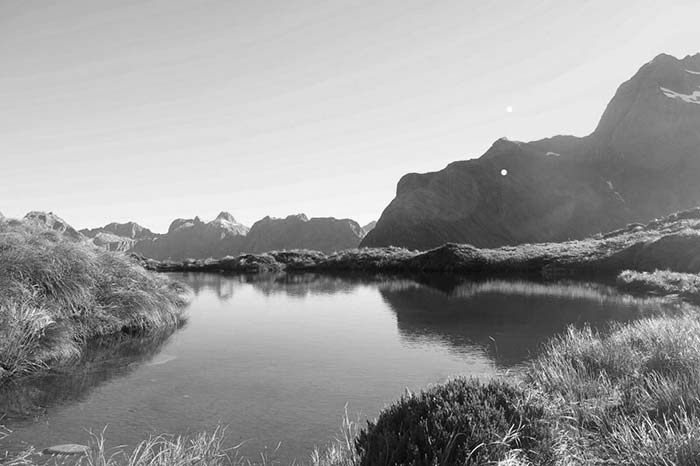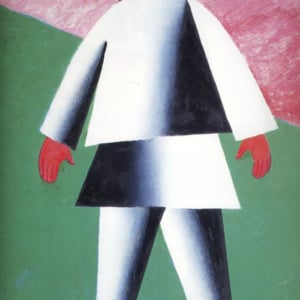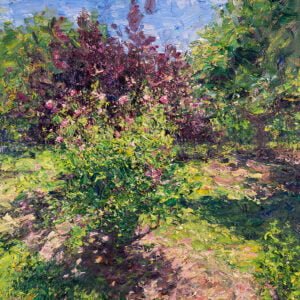Here are my top 10 painting hacks.
- 1. Stain the Canvas
- 2. Invest in High-Quality Paintbrushes
- 3. Take a Step Back From Your Painting From Time to Time, Walk Around It, View It From Different Angles, Hang It in a Different Light
- 4. Take Progressive Photographs of Your Painting
- 5. Use a Color Checker to Assist Your Mixing
- 6. If You Are Stuck on a Painting, Start a New Painting and Come Back to the One You Are Stuck on at a Later Time
- 7. Look at Your Painting in a Mirror
- 8. Make Your Reference Photo Black and White
- 9. Use a Grid to Assist Your Proportions
- 10. Stop Tracing and Buy a Proportional Divider
- Want to Learn More?
- Thanks for Reading!
1. Stain the Canvas
If you are just starting out, I would suggest you stain your canvas in a dull tone to give you a more balanced ground to paint on, rather than trying to paint on a glaring white canvas. White is an extreme value to paint directly onto and it can make it difficult to judge your values.
If you are more advanced, your judgment may be accurate enough that staining the canvas is not necessary.

2. Invest in High-Quality Paintbrushes
When I started painting, I was of the belief the quality of your paintbrush does not matter, but rather how you use it.
But I was wrong…
There is a massive difference between poor and high-quality paintbrushes in relation to the handling of paint. Poor quality paint brushes will not hold much paint or efficiently apply paint to canvas. The bristles will also be weak and deteriorate easily.
On the other hand, high-quality brushes will be responsive and apply your paint very efficiently and fluently to your canvas.
If you are on a limited budget, then rather than buying a heap of poor quality brushes (which you will need to replace very often), invest in a few high-quality brushes and learn how to take care of them.
3. Take a Step Back From Your Painting From Time to Time, Walk Around It, View It From Different Angles, Hang It in a Different Light
If you stay in one position whilst painting, you may overlook issues which can only be picked up from a different perspective.
Your fans will be viewing your painting from many angles, not just one. So keep active whilst painting.
4. Take Progressive Photographs of Your Painting
This will not only give you an interesting record of your painting but will also provide valuable insights on where you may be able to improve your painting.
Also, you can look at the progress photos during the day when you are not painting (i.e. when you are at work or on the train) to work out what the next steps will be with your painting.
5. Use a Color Checker to Assist Your Mixing
The mind is a powerful thing and can play many devious tricks on you in relation to your perception of color. The colors you think you see are not always the colors which are actually there.
Our perception of a color can be heavily influenced by the surrounding environment. Say for example you place a bright orange next to a red color. That bright orange may not seem nearly as brilliant as if you placed that same color next to a dull blue (which is a complementary color to orange).
We also have preconceived ideas of what certain objects are meant to look like which can alter how we perceive a color. For example, our idea of the sky is that it is blue. A common problem in beginner painters is they paint the sky with too much blue than what is actually there.
They are painting what they think is there not what they see.
A short term solution to this is to use a photo editing program (I strongly recommend all artists have Photoshop to clearly identify the colors in your reference photo.
You may be surprised at what the color checker picks up. Try and guess certain colors in the photo and then assess yourself with the color checker. This is not a long term solution though.
The long term solution is to train your own judgment so that a color checker is not necessary.
6. If You Are Stuck on a Painting, Start a New Painting and Come Back to the One You Are Stuck on at a Later Time
The solution to your problem can often be as simple as a single brush stroke, but it takes time to realize that. If you rush through a problem, you will more often than not overwork the painting.
7. Look at Your Painting in a Mirror
This will give you a completely different perspective of your painting. You will often be able to see issues which you may not pick up when standing in front of your painting.
8. Make Your Reference Photo Black and White
Value (how light or dark something is) is widely considered one of the most important elements of a painting.
If you are painting from a photo, then you can use photo editing software (Photoshop) to view your reference photo in black and white. This will give you an idea of the value range of the scene, without having to worry about color.
If you understand the dominant values in your scene, then the painting process will be much smoother.

I also recommend you purchase some kind of value finder which you can carry around with you. These are perfect for determining values in your reference whilst you paint (rather than having to analyze your painting in black and white after you have finished).
9. Use a Grid to Assist Your Proportions
You can place a grid over your reference photo and sketch a proportional grid onto your canvas. The idea is to try and match each respective portion of the grid on your reference to that of your painting.
However, this is just meant to be a guide. You will not learn anything if you just try and copy each segment without considering the painting as a whole. Use the grid to help you with the major structures in your painting but try not to rely on it.

You should also invest in a view finder which you can use to help find great painting compositions.
10. Stop Tracing and Buy a Proportional Divider
You will not learn anything from tracing, so if you are doing this then I suggest you progress out of it. Whilst tracing may give you a perfectly accurate perspective and proportions, it will not actually improve your painting abilities.
If you need some assistance with getting the right proportions in your painting, then you should purchase a proportional divider. Using a proportional divider is in no way ‘cheating’. In fact, it will help you identify where your judgment is lacking and will over time improve your judgment to the extent you may not even need it.
Want to Learn More?
You might be interested in my Painting Academy course. I’ll walk you through the time-tested fundamentals of painting. It’s perfect for absolute beginner to intermediate painters.
Thanks for Reading!
I appreciate you taking the time to read this post and I hope you found it helpful. Feel free to share it with friends.
Happy painting!
Dan Scott

Draw Paint Academy








Your 10 points were useful and validating. Thank you.
Thanks for the hacks- tips,they are very helpful, especially the tip on not painting on a white canvas, I always overkill on blue.
Thanks I’ve been using this for my fact checking resource guide..
Great tips. As a beginner painter, you taught me a lot.
I agree!
Like your painting Hacks most useful thanks you.
I like to hear from you as I am just starting.
to draw and paint.Any advice would be valuable.
Thank you so much. I’m going to check it out your free course.
After spending many hours in front of my painting, it is helpful to look at it through a mirror for a new perspective.
Brilliant! Perspective change does help a lot, and a mirror is an instant help to do just that. Nice tip!
Thanks Tommy!
If you really lose perspective on a painting, hold it in front of a mirror. It’s amazing how things you didn’t see will suddenly show themselves.
what liner brushes do you recommend?
Turning the painting upside down or looking at it in a mirror is a great way to instantly see what is right and wrong in the painting. Often we tend to exaggerate (unconsciously) towards one side or another, so this is an easy way to find that and correct it, along with any other inconsistencies.
I’ve been painting for a very long time and these are all great suggestions .
Great tips thank you, always good to pick up ideas.
I would like to learn the water image in painting
Something I was told to do yesterday by an art instructor: Take a photo of your work and change it to black and white. You can really see where you need to adjust values.
Great tip!
Some great tips! I have used Photoshop for years in my graphic design career, but never thought about using the color checker in my acrylic paintings. Seems like a ‘no-brainer’ now that you have pointed it out.
Very useful ideas.
Thanks for sharing
Thanks Nila!
Wonderful painting tips! Thanks for putting this together. Much appreciated!
Thank you for sharing Dan. So wonderful to learn and know. You are a great. Artist.
Thanks Monica! Dan
What a great list! Most of these are good reminders of things I’ve done and validation for things I use regularly, but #5 and #10 were new to me. I look forward to giving each of them a try.
Thanks Helen! Dan
What is a color checker you recommend?
Hi Karen. I personally do not use one as I prefer to rely on observation. But you can just grab a cheap one from your local art store or even Amazon. Dan
Thank you Dan for very thoughtful tips. I will get a proportional divider as a beginner in life drawing .
No problem Maureen! Thanks, Dan
This is a wonderful hacks list! Painting is something I’ve always wanted to do, but it’s always been more than I could afford. So I’ve used colored pencils and oil pastels to create my art. But as I was reading your list it occurred to me that these tips would also apply to other media like my pencils. Thank you for helping the art world in general to create.
Yes Patti, a lot of the information can be applied to any medium. Glad you enjoyed the article! Thanks, Dan
Another great article, thanks!
I had an art teacher in college once tell our class that our paintings and artwork, are only as good as, our paint brushes.
Also, thanks for the reference to Adobe and for the great suggestions about looking at our paintings in the mirror, Walk around them, in different light, etc. I think this will be most helpful for me, maintaining a fresh perspective, to keep my paintings fresh and my mind and eyes constantly viewing it with great attentiveness and care.
My pleasure Shelly! Just happy to help. Thanks, Dan
Great article, thanks a lot!!
No problem Isabel-Anne. Thanks, Dan
What is a value finder and how does it workÉ
I am recently retired and now have the time to enjoy what I would like to do. I will download (I hope) so I will be able to read and reread it as much as I need to. Thanks for the information and inspiration.
That is great to hear Linda! Enjoy. Dan
This was very helpful. Especially about angles and light.
AND the part about staining your canvas. I have several canvases in various sizes intimidating me with their glaring white brightness. What a relief to find this answer!
Thank you!
?
Happy this has helped you Mary! Thanks, Dan
I’m 11 years old love painting and these tips are great, they are helping me become a great painter! Are there any art classes you Recommend though?
Very useful tips ..thanks
Pravin
Very useful tips as a reminder to help artists paint more sucessful.
Many thanks
Thanks!! I learned some stuff, and also am pleased to know that I’ve already been doing much of it right.
Hi Dan
I read one of your articles on colour yesterday and it helped me get a good understanding on the use of oil paint, I just got stuck horribly thinking that I messed up, just to find that I was on track. But just got a better understanding on using oils.
I am thankful to find someone who share his knowledge freely. I think I can call myself an artist know. Among other things I wish you many blessings.
Worthy points , many that I can learn from. Difficult to argue with the encouragement to buy the best brushes you can afford….but….there is ever in art a contradiction and the contradiction for this one may be that Wolf Kahn uses disposable brushes. Again however,thanks for the worthy suggestions.
Yes of course
Hi Dan! I was wondering who is the artist who painted the cover photo you posted which says “10 Painting Hacks Every Artist must know.” It’s a beautiful painting, so I would love to know! Thanks
Is it advisable to stain your canvas when using acrylic paint?
A lot of information thank you.
It was very helpful for me to repeat the information about painting. Thank you very much.
Great tips, thank you!
Do you have a tutorial on using a proportional divider?
Check this and how to make one for nothing:
https://www.youtube.com/watch?v=nEZMKc0nMAg
I agree with all of your tips except number ten. I can sketch my own drawings, but I sometimes trace to conserve time. I find that it takes a great amount of skill to know what is worthy of tracing and what isn’t. In addition, one has to be able to paint what one has traced. Perhaps your idea of tracing and mine are different. I really do enjoy your tips.
You mentioned a real expensive graphic software which for a beginner is quite prohibitive. There are heaps of FREE software out there as good as the one you mentioned . Search for free graphic sofware.
Why would I want to keep acrylic paint wet longer?
Ouch. I painted on white. Now I want to find a way to cover that white a little. Anyway, helpful tips to keep in mind in the future!! Thank you.
Thank you so much for providing such amazing information.
God bless you
Hi Dan, With oil painting it is essential to seal the canvas with at least three coats of gesso to prevent the oils soaking through to the canvas otherwise they will rot the canvas in time.
When you buy a canvas it usually has a coating on it already but this is often not enough to protect the canvas. You could colour the top coat of gesso to avoid a white board.
Happy painting to you …. And it’s really very helpfull for me thanks a lot for this tips…can u please tell me that how to teach a person ‘painting’?
Hi Mahak. I will send you an email privately. Chontele